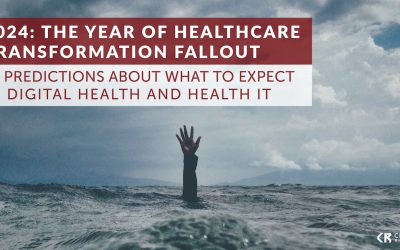Every year, the health IT industry follows a pattern. HIMSS inspires us, our heads and notebooks filled with visions of The Next Big Thing that will change healthcare delivery. But shortly after arriving home, catching up on sleep, and reintroducing vegetables to our diet, we return to the stark reality of trying to change healthcare delivery.
At the recent MIT Sloan Healthcare and Bioinnovations Conference, Dr. Holly Oh, CMO at Dimock Community Health Center in Roxbury, Mass., described a common occurrence at her facility. When patients are hospitalized at one of Dimock’s partners – not a rare occurrence for a community hospital mere miles from downtown Boston – relevant Dimock staff receive a fax, an email, and a notification via Mass HIway, the Bay State’s health information exchange (HIE) entity.
Dr. Oh said all three modalities are necessary because none of the three, on its own, is reliable enough. Speaking to the crowd of investors and inventors, she asked, “Why not try to fix that?”
The simple answer is that many of healthcare’s problems are not sexy. Better geriatric care, incremental behavior change, sensible insurance purchasing, and streamlined notifications would make a dramatic dent in the nation’s $3.2 trillion healthcare bill; sadly, none can be pitched as the “Uber for healthcare” panacea that every investor seems to fawn over.
The more complicated answer is that the purported solutions to so many of healthcare’s problems seem to be based on a series of assumptions that we have all heard, or even said ourselves. None of these assumptions have much merit. (See Table below.)
If there’s a unifying theme to these assumptions, besides snarky pessimism, it’s that they all focus on The System rather than The People. Meaningful use, insurance reform, value-based care, population health, artificial intelligence, cognitive computing – all aim to change The System without making real accommodations for The People who deliver care, receive care, and pay for care. The industry even treats social determinants of health primarily as a metric to add to a risk score, not as a worthwhile thing to discuss before sending patients on their way.
As a recent examination of the digital health market in The Economist concluded: “[I]t is worth remembering that the biggest winners from digital health care will be the patients who receive better treatment, and those who avoid becoming patients at all.”
As we look to bring to bear our own idea for The Next Big Thing, the journalist in me suggests honing in on the 5 Ws, plus an H:
- Who is going to use this solution? Design for patients is different than design for physicians – a lesson portal developers never learned.
- What problem does it intend to solve? A solution that tries to be all things to all people is unlikely to work – a lesson that care management vendors are beginning to learn.
- Where, in what setting, will the solution be used? Again, design for the hospital is different than design for the PCP office, the post-acute care facility, or the home.
- When will the solution be used? All too often, healthcare fails to design solutions for people at their worst – patients or physicians alike who seek information when they are sick, confused, burned out, or all of the above.
- Why use this solution instead of countless others? Follow the advice of AiCure CEO Adam Hanina (who also spoke at the MIT event) and put the value proposition in clear terms – not the technical stuff but, rather, “Do you have any idea how many of your patients take their medications?”
- How will this solution make a difference? Forget The System. Remember The People. (Can we put that on a T-shirt?)
Yes, framing your idea this way will likely make it less sexy. However, answering these questions will help turn your idea into a more concrete solution that best addresses the needs of the individuals living, working, and experiencing the healthcare system. Even reliable notifications about patient hospitalizations will have an impact.





0 Comments